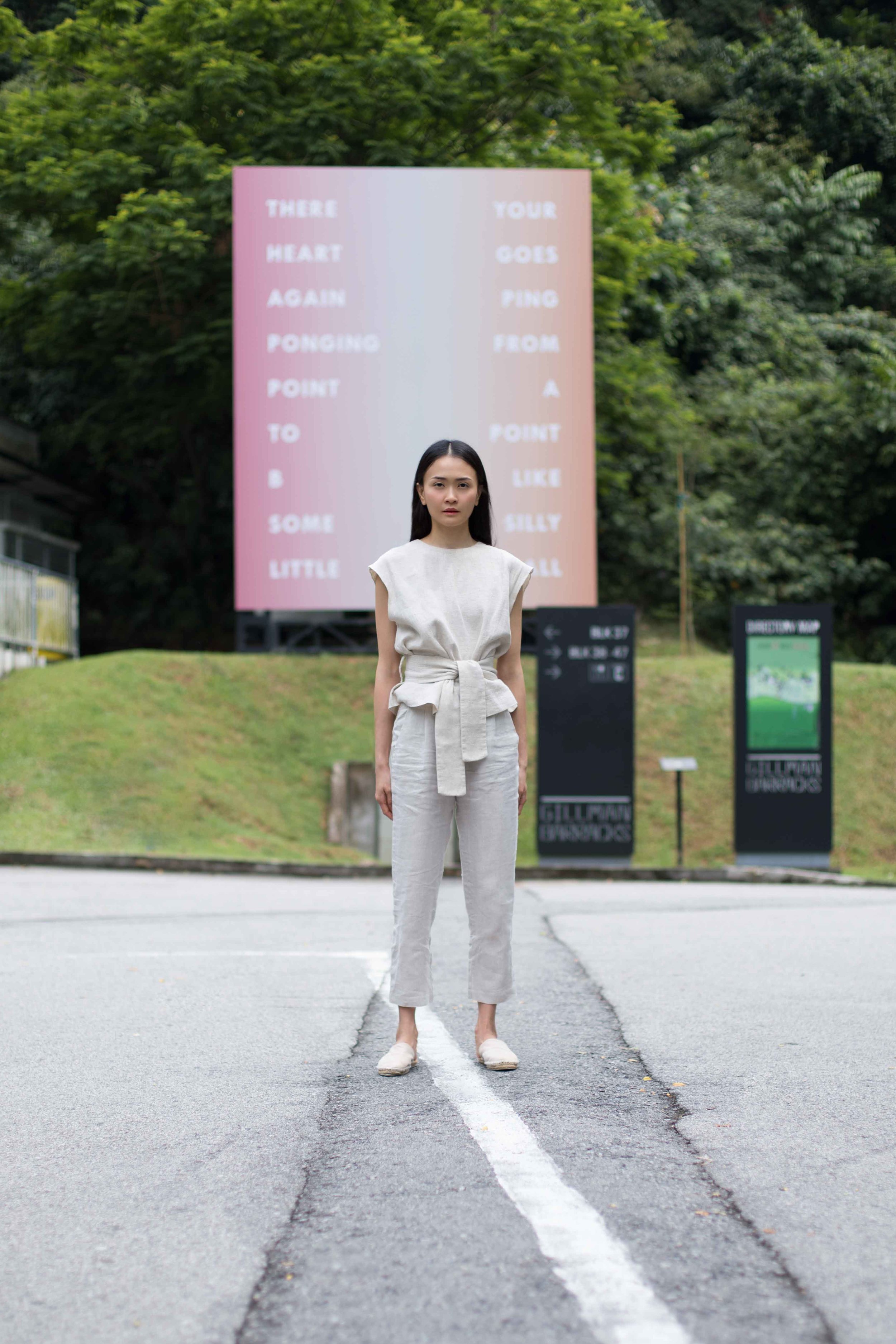DISINI Discovers – Dawn Ng
If you meet Dawn Ng in person, you come to realise that her work seems to be almost a mirror reflection of herself. In a lilting voice, she measures out her sentences carefully, conveying a gravitas that, like her work, with all its calming pastels and oversized inflatable rabbits, might not be immediately perceived. As an artist who explores the ideas of memory, self, and time, Dawn’s works are products of patience and labours of love; her piece for DISINI, Pinball—extracted from her body of work, Perfect Stranger—gives form to a year-long conversation she had with an Israeli child psychologist whom she never met. Here, she shares about why she creates without considering what the viewer thinks; how becoming a mother has made her hyper-efficient; and why she wishes she never had to sleep.
1/ Some of your work like Walter and A Thing Of Beauty have been about drawing attention to the things that are commonly overlooked, or go unseen. How did this idea become something that you wanted to explore?
I think there is infinite beauty to be found in the most common things. We instinctively understand that when we are young but it gets harder to hold onto that purity and innocence as you get older—the things that we become conditioned to see as beautiful become more elaborate, ornate, or pegged to its value. I am constantly amused that even the most everyday and ordinary objects or spaces can be pregnant with meaning and therefore precious.
3/ You led the creative direction for the design at fine dining restaurant Odette; how did that come about, and how was the experience different from creating an art piece/installation?
I was given carte blanche to approach the space like a blank canvas, so it began with creating a body of art. I spent a couple of weeks in the kitchen with Julien (Royer, Odette's chef ) when he was still working in Jaan. I was inspired by the food—he has always been obsessed about his ingredients and the quality of the produce. I spent a lot of time going through raw materials, everything from oyster shells, to the black glossiness of caviar, and the texture of truffles, and I think all those things which I photographed later became the abstract shapes that we hung on the walls. It was a liberating brief to work on that culminated in a fragile canopy of hand-cut mobiles and collages, which were then woven into the logo and design touch points throughout the restaurant.
6/ How do you feel the text for Pinball manifests itself differently from your work in Perfect Stranger— from the pristine white floor of the gallery, in a very contemplative experience, to a 5-metre tall billboard that can be seen from the end of the road?
In one instance, the work is on the ground and in the other, it’s up in the sky. I like that they are extremes of each other. Extremes actually share the greatest similarities. For something that’s resting on the ground, there’s a form of formality—the only time you see things on the ground is tombstones. There’s an element of something that’s spiritual and therefore I visited the similarity of the two.
11/ Your work spans from collage to photography and illustration; to light, space, and ephemeral installations—which medium do you enjoy working with the most?
I have always been promiscuous with mediums. I think the idea informs the form, not the other way around.
12/ What do you hope to make people think/feel through your art?
I never think about that. I don’t work with an agenda. Not even with hope. I think doing so has a way of adulterating your work.
13/ Do you think becoming a mother has changed the way you work?
On a practical level, motherhood has made me hyper-efficient in my approach, and more focused in my process. I just don’t have the luxury of time to muck around or get messed up.
14/ Childhood pastime:
Documenting and collecting things. I collected all sorts of random things—I used to be an avid leaf and bottle cap collector too. I think I was always documenting, even the conversations I’ve heard. I would always write down interesting conversations.
2/ You’ve also mentioned that you’re led by your own compulsions; have these ‘compulsions’ or concepts that you explore always been the same since you started?
I have always been obsessed with the notion of memory, self, and time. In Perfect Stranger (the ongoing exhibition at Chan+Hori Contemporary), I’m exploring this idea that we each exist as vessels of vanishing selves. Oftentimes, when someone says he misses something, he often alludes to a time, person, or place, when what he truly misses is a version of himself that he can never get back to again. I am interested in those missing people within us.
4/ Is this something you see yourself doing more of in the future?
Unless it has the same integrity and the same promise of creative liberty, I would never take on another commercial project.
5/ Your latest series and exhibition Perfect Stranger is very personal—which piece spoke to you the most?
It would have to be the fictional narrative True Story, but I think it is as much my story, as it is anyone else’s.
7/ Can you tell us about the process behind creating a new piece of work?
I’ve said this before—that every new project is akin to approaching a stranger. For the most part, I am open; curious, more than anything. I always want to believe in the infinite possibilities of any encounter but in the end, it takes some form of falling in love—that level of compulsion, investigation, obsession, and faith to bring a project into form.
8/ What’s something you wish you had more time to be doing?
I always wish that I didn’t have to sleep. Sleep is such a waste of time—we spend one third of our lives just sleeping and if we didn’t have to do that, I’d just be seeing more and taking in more.
9/ Any advice you’d give to aspiring artists?
That ideas are cheap and execution is everything. Anyone can have a good idea and I think it’s about having the rigour and doggedness to see it through—that really separates the people who talk about great things and the people who do them.
10/ Was there a project or piece that was particularly memorable or meaningful to you, or something close to your heart?
Each work is akin to a memory; there’s no particular favourite. The beauty is in their entirety.
15/ First memory of art:
When I was growing up, my mother would always take me to the National Library—it was where YMCA is today—and at that time, she’d draw out what I liked in the books. It was my way of keeping it, so we had books and books of drawings of things I liked from other books. My mum’s a draughtsman in an architect’s office so she was always drawing. She’s really good at copying form.
16/ If you could travel in time, either backwards or forwards, which moment would you want to visit?
I think…always backwards. It would be have to be each moment that I had a ‘first time’, because it's something you can never re-engineer.
17/ What drives you to continue doing what you do, day in and out?
The need to tell stories that are true to me.


